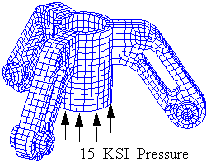XXXXXXXXXXXXXXXXXXXXXXXXXXXXXXXXXXXXXXXXXXXXXXXXXXXXXXXXXXXXXXXXXXXXXXXXXXXXXXXXXXXXXXXXXXXXXXXXXXXXXXXXXXXXXXXXXXXXXXXXXXXXXXXXXXXXXXXXXXXXXXXXXXXXXXXX''"> Problem Description
A model aptly named the spider model because of its unique shape, is fixed at the shafts of its three legs. The center shaft is subject to a fully reversed 15 KSI amplitude pressure loading on its underside that oscillates in a sinusoidal fashion. A linear static finite element analysis was performed using MSC Nastran with this load magnitude of 15 KSI.
Everything that you have learned thus far using MSC Fatigue and the Total Life method is now also applicable to the next method of fatigue life prediction. We will build on this knowledge to introduce and explain the Crack Initiation method, sometimes known as the local strain or strain-life method. As the name implies, the failure criterion now is life to initiate a crack. Once an engineering crack appears, failure is said to have occurred.
Objective
• To introduce the Crack Initiation method
• To understand cyclic hardening/softening
• To learn how cyclic stress-strain and strain-life curves are created
• To understand how plasticity is accounted for
• To relate stress-life to strain-life prediction methods
Table 5‑1 File |
P3_HOME/mscfatigue_files/examples/spiderCI.op2 |

